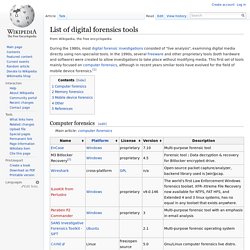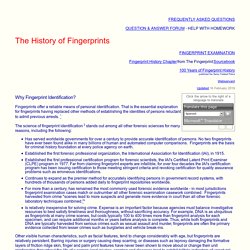

List of digital forensics tools. During the 1980s, most digital forensic investigations consisted of "live analysis", examining digital media directly using non-specialist tools.

In the 1990s, several freeware and other proprietary tools (both hardware and software) were created to allow investigations to take place without modifying media. This first set of tools mainly focused on computer forensics, although in recent years similar tools have evolved for the field of mobile device forensics.[1] Computer forensics[edit] Memory forensics[edit] Memory forensics tools are used to acquire and/or analyze a computer's volatile memory (RAM).
Mobile device forensics[edit] Mobile forensics tools tend to consist of both a hardware and software component. Other[edit] References[edit] List of serial killers by country. The History of Fingerprints. Fingerprints offer a reliable means of personal identification.

That is the essential explanation for fingerprints having replaced other methods of establishing the identities of persons reluctant to admit previous arrests. 1 The science of fingerprint identification 5 stands out among all other forensic sciences for many reasons, including the following: Other visible human characteristics, such as facial features, tend to change considerably with age, but fingerprints are relatively persistent. Barring injuries or surgery causing deep scarring, or diseases such as leprosy damaging the formative layers of friction ridge skin, finger and palm print features have never been shown to move about or change their unit relationship throughout the life of a person (and injuries, scarring and diseases tend to exhibit telltale indicators of unnatural change). In earlier civilizations, branding or maiming were used to mark persons as criminals. AD 1400s - Persia 1600s 1685 - Bidloo 1788 - Mayer Dr. Bloodstain Tutorial. The success or failure of any criminal investigation often depends on the recognition of physical evidence left at a crime scene and the proper analysis of that evidence.

Crime scenes that involve bloodshed often contain a wealth of information in the form of bloodstains. The pattern, size, shape, and the location of such stains may be very useful in the reconstruction of the events that occurred. William G. ECKERT and Stuart H. JAMES Bloodstain Pattern Analysis: CSI: THE EXPERIENCE — Web Adventures. Crimeline * history of forensic sciences * history of criminology * toxicology * fingerprint * dna analysis * autopsy * arsenic * poison. The Criminology Mega-Site. The 10 Worst Execution Methods Ever Devised.
How Technology Is Changing Criminal Linguistic Evidence In Court. The man who cleans up blood after murders. Image copyright Bénédicte Desrus / Alamy Mexico has one of the highest murder rates in the world, but who cleans up the blood at the crime scene when the police and investigators have left?

Donovan Tavera is Mexico's first forensic cleaner. As he explains here, his fascination with blood began as a young boy. What happens to the blood after a murder? The question haunted me for years, until I answered it myself. The first time I saw a dead body was when I was 12 years old. As well as us bystanders there were police officers and investigators. I asked her: "Who cleans the blood after a murder? " When my father came home from work I asked him too: "What happens to the blood after a murder? That was when I decided to find out for myself. A murder isn't the same as an accident - in a murder there is a lot of blood. When I was about 17 I started experimenting. And that's how I became a forensic cleaner. Over the years I have invented more than 300 different formulas to clean up blood. Decomposition. FACTS: WHAT HAPPENS TO A BODY AFTER DEATH (WARNING - Not for the squeamish) UPON DEATH Nature is very efficient at breaking down human corpses.

When you die your heart stops pumping blood around your body, thus depriving your cells of oxygen, which rapidly begin to die. Decomposing starts almost immediately, with the skin going through several changes in colour as the blood stops circulating leaving the body an ashen color. However different cells die at different rates. For example, brain cells die within a few minutes, whilst skin cells can survive over 24 hours after death. Upon death blood also starts to settle in the those parts of the body that are closest to the ground, turning the top part grayish white and waxy looking, whilst darkening the underside. Taphonomy: What Happens To Bones After Burial? Last week I discussed a way of preserving bodies almost indefinitely in some cases: embalming.

On the other side of this is decay, the process of bodily decline and biological breakdown of the flesh. If you’ve ever watched any of the forensics crime shows, you know that understanding decay and changes in the body can be a key factor in determining when the individual died and how the body was treated after death. But its also important for archaeologists dealing with remains that are ancient.
First, let’s look at the early stages of decay. The Bugs That Decompose Bodies and Help Solve CSI Secrets. CSI Test - Crime Scene Investigation Test. Crime Scene 15 PPT.